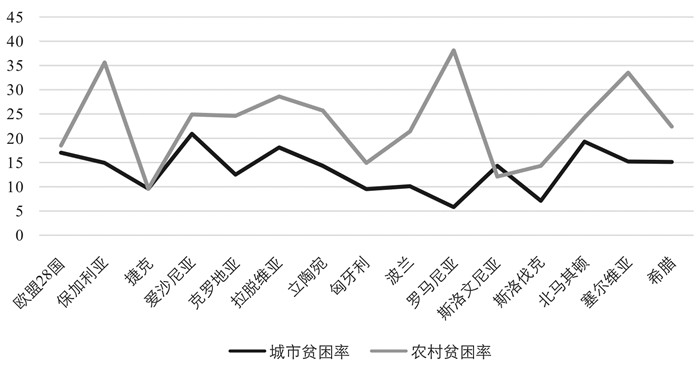-
2021年2月,习近平在中国-中东欧国家领导人峰会上发表了《凝心聚力,继往开来 携手共谱合作新篇章——在中国-中东欧国家领导人峰会上的主旨讲话》,强调同各国实现更高水平的互利共赢。中东欧17国地处欧洲东部与中部,包括阿尔巴尼亚共和国、波斯尼亚和黑塞哥维那、保加利亚共和国、克罗地亚共和国、捷克共和国、爱沙尼亚共和国、匈牙利、拉脱维亚共和国、立陶宛共和国、北马其顿共和国、黑山、波兰共和国、罗马尼亚、塞尔维亚共和国、斯洛伐克共和国、斯洛文尼亚共和国和希腊,既是“一带一路”沿线重要的国家,也是中欧合作的“桥头堡”。2020年,中东欧17国的整体名义GDP约为2万亿美元,占欧盟区的13.7%,全球的2.3%[1]。其中,波兰、匈牙利、罗马尼亚等国家增长强劲,增速均超过4%[2]。自1989年以来,中东欧国家历经了东欧剧变、政治经济体制转型、国际金融危机、欧债危机、乌克兰危机等重大事件,在二十几年风雨飘摇中踉跄前行,虽然目前经济发展势头较好,但失业率高、贫富差距大和财政赤字仍是当前中东欧国家面临的重要问题,也是社会贫困现象产生的主要原因,在一定程度上制约着中东欧社会的未来发展。在中东欧国家面临反贫困严峻形势的今天,加强国际反贫困合作是实现中东欧可持续发展的必然选择。
贫困问题不仅是全世界共同面对和亟待解决的现实难题,更是阻碍当今世界经济社会发展的最大挑战,消除贫困是实现世界可持续发展的重要目标之一。2015年9月,联合国将“在世界消除一切形式的贫困”列为《2030年可持续发展议程》的首要目标。改革开放四十年以来,中国已经成功使7亿多人口摆脱贫困,在2020年底前如期完成脱贫攻坚任务,使最后的551万贫困人口全部摘帽,历史性地解决了困扰中华民族几千年的绝对贫困问题,提前10年实现《联合国2030年可持续发展议程》减贫目标,书写了世界反贫困史上的伟大传奇。
2012年,中国与中东欧国家举办了第一次领导人会晤,自此,双边合作不断加强,合作领域不断扩大且倾向多元化。中国与中东欧双方都面临着严峻的反贫困挑战,其反贫困目标一致,反贫困需求相似,具有广泛的合作基础和途径,因此,加强中国在“一带一路”倡议下与中东欧各国反贫困领域的合作,分享中国反贫困的优秀经验,对加快该地区的脱贫步伐,顺利完成联合国2030年可持续发展议程,构建人类命运共同体,具有十分重要的意义。
全文HTML
-
国家间的反贫困国际合作按照主体不同主要划分为两种:一种是由联合国和世界银行代表多边国际发展组织提供的国际合作平台;第二种一般为国家间双边合作或援助,这种合作一般都是政府间的官方行为,此外还有一些国际非政府组织提供的非官方合作和援助等[3]。现将从20世纪80年代以来国际社会反贫困合作历程综述如下:1981年联合国召开了最不发达国家问题会议,提出促进最不发达国家的体制改革,为贫困人口提供国际认可的最低生活标准。提出发达国家要以其国民生产总值的0.15%来支援最不发达国家[4]。1990年联合国召开了第2次最不发达国家问题会议,重申1981年大会0.15%的达标要求,并希望在世纪末达标的国家争取达到0.20%。1992年在第47届联合国大会上将每年的10月17日确定为“国际消除贫困日”,要求各成员国切实采取行动,消除世界贫困[5]。1995年联合国社会发展世界首脑会议要求各国制定消灭贫困的综合战略,并确定1996年为“消除贫困国际年”[6]。2000年联合国千年首脑会议通过了“千年发展目标”,承诺到2015年之前世界极端贫困人口和饥饿人口减半[7]。2004年全球扶贫大会交流国际扶贫经验,提出新的扶贫举措,从而推动全球扶贫事业的发展[8]。
从区位优势来看,中东欧17国是欧洲的“东大门”,是“一带一路”建设的重要枢纽,也是中国产品进入西欧市场的必经之路,中东欧各国与中国经济的互补性较强。近年来,尤其是“17+1”合作框架以及“一带一路”倡议提出以来,中国与国际的反贫困合作越来越紧密,取得了长足进步,许多学者对“一带一路”沿线国家反贫困合作的模式和路径进行了相关研究。I Karasková等对中国与中东欧“17+1”合作机制进行多角度分析评价,在“一带一路”框架下贸易投资日益增长,基础设施不断完善,各国共同利益得以实现[9]。Iulia Monica O I认为“16+1”合作模式为区域合作的创新方法,在实践中,这种模式在很大程度上是双边高度竞争的性质[10]。Kizeková A认为在“16+1”模式中中东欧的经济和政治影响力不断扩大,另一方面,其软实力基于文化交流和高级外交对话也得以增强[11]。万秀丽等发现“一带一路”沿线国家发展不稳定因素上升且贫困多元化现象严重,提出以共商共建共享为基本原则推动构建减贫治理责任共同体、以互联互通为发展主线助力沿线国家转向“造血式”减贫[12];郝蕾在研究中国与南亚国家合作反贫困的进程中,提出要加强政策沟通,筑牢战略互信,精心做好顶层设计[13];王志章提出产能合作既是"一带一路"建设亮点之一,也是沿线国家间合作的重要支点,是实现内外双收益和发展共赢的客观基础[14]。华红娟提出采用分层分类合作模式,在“一带一路”框架下开展中国与中东欧国家的“精准合作”[15]。贾甫结合“一带一路”沿线国家跨越中等收入陷阱及其贫困陷阱的现实,在产品生命周期理论框架下,探讨了“一带一路”与全球产业升级的关系[16]。黄林秀等从市场开放视角分析了“一带一路”国家经济制度质量对中国OFDI具有显著影响[17]。
综上所述,反贫困国际合作通常都在联合国框架下进行,在联合国等国际组织的积极努力下,发达国家和发展中国家都将反贫困作为一项共同事业,采取行动纲领进行合作,把消除绝对和相对贫困作为合作的共同目标。全球化的反贫困目标和行动逐步趋向一致性,在中国“一带一路”框架下,反贫困合作实现新的合作模式,基于产能合作、贸易投资以及基础设施建设等方面的合作,为减贫发展提供了新的思路和借鉴。中国与中东欧国家的反贫困合作,为中国和中东欧国家的发展带来了新的机遇,因此,进行反贫困国际合作不仅有利于民族国家和地区的稳定而且有利于国家可持续发展。
-
尽管目前经济形势良好,但中东欧大部分地区仍未走出历史遗留的困境,基础设施匮乏、人民生活质量欠佳、贫困问题突出,严重制约了中东欧的经济社会发展。纵观中东欧国家贫困现状,主要呈现以下形态。
一是贫困率高且贫困基数相对较大。欧盟统计局通过调查分析成员国的贫困现状,按照家庭可支配收入低于全国平均水平的60%、生活物资严重短缺、工作时间过少等三大标准来确定成员国面临贫困或社会排斥风险的人数和比例。中东欧国家与西欧北欧发达国家相比,面临贫困或遭遇社会排斥的人数比例更高,贫困体量更大。2019年,欧盟国家面临贫困或遭遇社会排斥风险的比例均值为21.1%,保加利亚(32.5%),罗马尼亚(31.2%)等国家比例超过了欧盟平均水平,其中保加利亚比例最高,是欧洲贫困程度最深的地区之一(见表 1)[18]。从人均年收入来看,中东欧国家的贫困程度也高于西欧和北欧国家,以人均GDP为例,2019年阿尔巴尼亚人均GDP为0.54万美元,波黑人均GDP为0.61万美元,甚至不及挪威人均GDP的十分之一[19]。
二是社会贫富差距大。20世纪90年代,中东欧经历了涉及政治、经济、外交等多个领域的社会转型,经济转轨导致社会生产资料及物质财富重新分配,这一时期中东欧国家贫富分化现象明显,人民生活水平急剧下降,贫困程度大大加深。数据显示,1993-1995年间中东欧国家的年均基尼系数较转型前大幅增加[20]。步入21世纪后,中东欧国家积极加入经济全球化浪潮,随着资本和财富大量流向高收入阶层,全球化的负面溢出效应逐渐突显,进一步加剧了中东欧的贫富差距。保加利亚的基尼系数自2013年起逐年递增,并在2019年达到了峰值,高达40.8%,超出了收入分配差距的“国际警戒线”,高出欧盟国家平均水平10.6个百分比[21]。2019年,罗马尼亚最富有人群的总收入是最贫困人群总收入的7.1倍,贫富差距居欧盟国家第三位[22]。
三是贫困程度区域差距大。中东欧17国资源禀赋、发展程度和经济实力各不相同,贫困率也存在显著差异。总的来说,维谢格拉德集团四国贫困程度最轻,波罗的海三国和东南欧五国次之,西巴尔干五国贫困程度最深。采用家庭可支配收入低于全国平均水平的60%作为贫困标准线,处于中欧的捷克、斯洛伐克是欧洲贫困程度最轻的国家之一,2009年至2019年,捷克贫困率一直保持在10.1%以下,而黑山共和国2019年贫困率为24.5%,为欧盟最高[23],可以看出中东欧每个国家的贫困程度差异较大;与西欧国家城市贫困率高于农村不同,中东欧农村地区由于地处偏远、基础设施落后等原因,贫困率远高于城镇地区。在欧盟成员国(含候选国)中,罗马尼亚、保加利亚、塞尔维亚和拉脱维亚是乡村贫困率最高的四个国家。此外,中东欧城乡贫困率差距也比西欧大得多,罗马尼亚、保加利亚、立陶宛和塞尔维亚尤为显著(见图 1)。
四是罗姆族贫困问题突出。罗姆族是欧洲数量庞大的民族群体,由于历史原因,大部分罗姆人居无定所,多以流浪乞讨为生,长期受到其他群体的排斥与歧视,罗姆族贫困问题是中东欧国家面临的最具挑战性的发展问题之一。一方面,罗姆族深陷极度贫困问题困扰,据保加利亚2011年人口普查,罗姆族失业率为49.8%,土耳其族和保加利亚族的失业率分别为25.7%和12.3%。同年,据欧盟针对罗姆人生存状况的调查,中东欧各个国家罗姆人贫困率与国家整体贫困率差距很大。
五是单身女性、单亲家庭、儿童等弱势群体贫困问题严重。与男性相比,中东欧单身女性面临着更高的贫困风险。在职场上,单身女性更容易受到就业歧视,失业率高是导致中东欧单身女性贫困的重要原因之一。2019年,欧盟国家单身女性的平均贫困率26.6%,同年,爱沙尼亚单身女性的贫困率高达51.4%,拉脱维亚为52.6%,立陶宛为46.3%,分别位列欧盟国家前三[24];单亲家庭由于要独自承担抚养孩子的义务,经济压力相较于普通家庭来说更大,也更容易陷入贫困状态;由于中东欧国家大量青少年早早辍学,教育水平有限的孩子即使长大成人也难以找到一份满足温饱的工作,多数仍在贫困边缘挣扎[25]。
六是多维极端社会现象突出。中东欧地区的贫困问题不仅表现为收入贫困,还呈现出多维、复杂、非物质的相对贫困特点。除物质贫困外,经济转型还给民众带来了较为严重的心理创伤和精神贫困。转型十年间,中东欧国民生活满意度远远低于西欧平均水平。时至今日,经济转轨的余温仍影响着人们的生活态度。贫困率的大幅上升造成了大量的社会问题,酗酒、自杀、民族冲突、社会排斥等现象随处可见,全球自杀率排名前十的国家中,有九个是中东欧转型国家,立陶宛位居榜首。此外,大面积的贫困导致中东欧犯罪率大幅上升。2009至2019年,保加利亚犯罪、暴力或故意破坏行为的发生率一直维持在20%以上[26]。
-
第一,经济转轨导致贫困发生率激增。从1988年到1998年转型十年间,中东欧地区的贫困率由2%增至21%。首先,经济转轨导致大量民众失业。2013年,希腊失业率为27.5%,克罗地亚为17.3%,远高于国际失业率警戒线[27]。其次,经济改革过程中社会阶层的重新划分产生了新的剥削阶层和特权阶级,加剧了制度性及阶级性的财富分化。最后,为了克服经济转型带来的财政危机,中东欧国家大刀阔斧地改革社会福利制度,取消了生活补贴和失业救助,使得相当一部分人因失业或工资不足而陷入贫困。政治经济转型距今虽已过去二十余年,但有研究表明其对中东欧地区贫困、贫富差距大等社会问题的影响依然存在。
第二,金融危机使中东欧再陷困境。2008年金融危机使得依赖外资的中东欧国家受到了严重的传导影响,本币贬值,债务负担加重,失业率激增,经济出现负增长(见表 2)。2008年,中东欧地区拉脱维亚和爱沙尼亚经济衰退最为严重,两者的GDP实际增长率降至-2.77%和-5.33%。此外,中东欧国家的长期失业率格外突出[28],金融危机使得大量中东欧民众失去工作,基本生活得不到保障,贫困问题日趋严重。同时,金融危机还导致中东欧各国的工资水平大幅下跌。受新冠肺炎疫情影响,2020中东欧国家GDP都呈现负增长。
第三,落后的基础设施制约经济发展。以波兰的公路建设为例,截至2016年7月,全国公路总里程超过41.2万公里,但优质公路占比极低,高速公路占比更少。匈牙利的匈赛铁路大部分路段均为单线,屡遭战乱破坏,加之年久失修,设备严重老化,铁路平均时速仅为35-40公里每小时。截至2019年3月,中东欧地区仍有大量比例的居民从未使用过互联网[29]。落后的基础设施严重阻碍了中东欧地区资本、货物和人才的充分流动,隔绝了落后地区与外界的联系,进一步加剧了地区贫富差距。
第四,国内腐败问题严重。中东欧地区的腐败问题并没有因为国家政治经济转型而有所减缓,反而在二十多年的社会变迁中愈演愈烈,严重制约了国家经济社会发展和民生福祉的改善。在2018年全球清廉指数报告中,中东欧国家远低于大部分欧洲国家的清廉水平(见表 3)。腐败和官僚主义的盛行会进一步加剧国家的贫富分化,极易出现反贫困资源被滥用的情况,增加了中东欧地区反贫困的难度。
一. 中东欧贫困现状分析
二. 致贫的主要原因分析
-
当前中国与中东欧国家关系面临着新的发展机遇。在经济形势衰退,欧盟经济增长乏力,中东欧亟需谋求与欧元区以外的国家进行贸易与投资合作。随着中国经济实力与国际影响力的迅速提升,双方关系日趋密切,中东欧推行“向东开放”的国家发展战略与中国“一带一路”倡议不谋而合。反贫困是中国与中东欧国家的共同目标,中东欧国家通过稳步推进与中国的合作关系,利用“一带一路”倡议这一平台探索合作反贫困的新方法、新模式和新路径,能有效减缓本国贫困问题,实现双方互利共赢。
-
近年来,中国与中东欧国家不断探索合作机制,努力深化双边关系,形成了政府主导、民间参与的合作模式,呈现出旺盛生命力和强大吸引力,极大地促进了双方合作反贫困的进程。
在政府层面,中国与中东欧国家着力做好反贫困合作的顶层设计。首先,反贫困合作是双方领导人会晤的重要议题。目前已签订8份中国—中东欧国家合作纲要,始终把基建合作、互联互通等民生工程放在优先位置;其次,双方积极召开交通、经贸等促民生反贫困的部长级会议,推动产能和装备制造合作,培育贸易新增长点,创新融资模式,将关注民生福祉的合作项目落到实处,增强对贫困地区的带动作用。
在民间层面,中国与中东欧国家积极夯实合作民意基础。双方通过举办各类民间论坛、会议、博览会等活动促进在教育、文化、卫生等领域的合作交流。截至2018年底,中国与中东欧国家双向留学人员达12 000人。举办“16+1”农产品博览会,搭建中东欧农产品电商物流中心,推动中东欧优质农产品走出国门;举办中国与中东欧青年政治家论坛,推动双方青年就合作反贫困问题进行交流互访;举办旅游合作高级别会议,探索挖掘贫困地区旅游资源促进区域发展的新模式;在中东欧国家开设孔子学院,搭建文化交流平台。截至目前,中东欧每个国家都建设了孔子学院,共计30所孔子学院,32个孔子课堂[30]。通过各种民间合作方式加大了中国与中东欧国家双方民间的交流互动,夯实了开展双边和多边反贫困合作的社会民意基础。
-
在反贫困合作领域,中国与中东欧国家着力丰富多边合作内涵,双方合作需求形成互补,基础设施建设被视为合作减贫的重点支持项目,通过龙头项目合作发挥引领作用,带动贫困地区发展。
在“一带一路”框架下,中国与中东欧国家积极拓展基础设施合作领域,着力打造安全高效的海陆空互联互通网络。在陆路方面,双方积极推动铁路公路合作建设,加强物流基础设施投资合作,推动货物双向流动。例如被视为塞尔维亚、匈牙利与中国共建“一带一路”的旗舰项目——匈赛铁路,它的建成将有效提振中东欧经济、推进交通便利化;在海运方面,双方积极推动海上互联互通,加强在内河航运、港口建设、多式联运、海上安全及航海保障等领域的合作。例如,2014年底,中国、塞尔维亚、匈牙利和北马其顿四国政府联合宣布建设的“中欧陆海快线”项目,通过海路联运的方式大大提升中欧商品流通的效率;在空运方面,双方加强在运输航空和通用航空领域的合作,鼓励双方航空企业在中国与中东欧国家之间开通更多航线。目前,上海—布拉格、成都—布拉格,北京—华沙、宁波—布达佩斯、宁波—布拉格等五条直航航线将中国与中东欧地区紧密连接起来,为双方商品流通和人员流动提供了极大的便利。
-
中国与中东欧国家搭建了多个平台参与合作反贫困。第一,双方拥有多层次合作交流平台。以领导人会晤、部长级会议等政府间不同层级的交流合作机制为主,地方、民间、具体领域等多维度互动交流机制为有益补充,双方通过多层次合作平台共同商讨反贫困项目,加强合作反贫困的深度与广度;第二,双方拥有丰富的资金平台。目前已有包括“中国—中东欧投资合作基金”、1 000亿人民币丝路基金等多种资金平台;第三,综合利用各种展会平台。通过多样化的双向合作交流平台,能够将对方优秀的政府官员、学者、企业家“请进来”,也能推动本国偏远地区的优势商品“走出去”,提升经济发展对贫困地区的辐射带动作用;第四,搭建网络宣传平台促进合作反贫困。双方通过“中国—中东欧国家合作”官网、中国外交部公共外交办公室微博“外交小灵通”等新媒体网络宣传平台普及民生合作项目讯息,加深双方彼此了解,助推合作反贫困进程。
-
一方面,互设金融支持机构,推动本币结算。2002年2月,中东欧地区第一家中国银行分行——匈牙利中国银行正式成立;2013年9月,中国人民银行与阿尔巴尼亚银行、匈牙利中央银行签署双边本币互换协议,推动本币结算。同时,中东欧国家也在我国市场设立了相应金融机构。2017年11月,中国-中东欧银联体正式成立,旨在为“16+1合作”重点项目提供多边金融支持,以加强金融合作,提高各国人民福祉。
另一方面,改善贸易便利化服务。截止2020年,中国与中东欧17国贸易额达到1 034.5亿美元,首次突破千亿美元,增长8.4%,高于同期中国对外贸易增幅和中欧贸易的增幅[31]。为推进中国与中东欧国家的贸易便利化程度,优化经贸投资环境,双方致力于推进通关质检领域便利化措施全覆盖,优化质检流程,缩短通关时间[32]。以海关质检为例,中国已同罗马尼亚、匈牙利、波兰、斯洛文尼亚等国签署了海关质检合作协议。2017年6月8日,浙江宁波成立全国首个针对“一带一路”倡议的国检试验区——“中国—中东欧国家贸易便利化国检试验区”,将在确保疫情疾病和质量安全可控的前提下,缩短交易时间,提高交易效率,探索优化贸易检验检疫监管模式。
一. 做好合作顶层设计,夯实合作民意基础
二. 丰富多边合作内涵,发挥龙头项目引领作用
三. 搭建多元合作平台,扩大领域惠及民生福祉
四. 建立健全合作支持体系,营造良好服务外部环境
-
随着中国与中东欧国家“17+1”合作机制的稳步实施,双方合作关系日趋密切,协同创造更多财富普惠贫困群体,合作反贫困成效显著,具体体现在增加就业、改善民生、促进偏远农村发展三方面。
-
中国与中东欧国家通过经贸投资、基础设施合作等方式不断扩大合作范围,创造了大量就业机会,有效改善了当地失业贫困状况。
在经贸投资合作方面,2016年10月,京西重工在捷克海布市正式投产,投资金额达7.6亿克朗,为当地创造300余个就业岗位;2017年5月,中国与立陶宛签署牛肉对华出口议定书,能为立陶宛40万肉牛从业人员带来更高的收入和更多的就业机会[33],2019,中国与希腊最大港口比雷埃夫斯港签署合作协议,为希腊当地创造了3 000个直接就业岗位。
在基础设施方面,双方在“一带一路”框架下依托“17+1”合作机制建设了大批基础设施项目,为中东欧地区创造了大量就业岗位。例如,2017年11月,中国与罗马尼亚签署了关于《切尔纳沃德核电站3、4号机组开发、建设、运营和退役谅解备忘录》,该项目建成将为罗马尼亚相关行业创造至少1.6万个直接工作岗位,能有效缓解当地就业压力[34]。由中水电集团七局承建的北马其顿基切沃—奥赫里德和米拉蒂诺维奇—斯蒂普两条高速公路是中国和北马其顿合作共赢的成果,为北马其顿带来大量工作岗位,有效契合“以工代赈”的反贫困方式,缓解失业贫困问题。
-
五年来,中国与中东欧国家在基础设施建设、中医药等领域的合作大大改善了中东欧地区的民生福祉,具有良好减贫效应。
在基础设施建设方面,中国政府在资金、技术、产能装备上的优势对中东欧国家基建升级发挥了巨大的推动作用,大批建成或在建的基础设施项目产生了良好的社会效益,显著提升了该地区居民的生活质量,极大地促进了亚欧之间的互联互通。例如黑山南北高速公路工程,它的建成将有助于解决黑山南北发展不均衡的现实问题;阿尔巴尼亚拜拉特绕城公路项目,该项目有效预防洪水灾害发生,促进该市新城区建设及旅游业的发展;2020年中欧班列共开行1.24万列,可通达中东欧国家的8个城市,促进了互联互通建设有序推进。
中国与中东欧国家在中医药领域合作具有悠久的历史。中方支持中东欧国家进一步开展中医药研究与合作,支持设立更多中医药机构,鼓励扩大中药材种植及生产。2015年6月,捷克首家中医中心成立。2017年3月,中东欧中医药学会联合会在匈牙利首都布达佩斯成立。2017年9月,中国与中东欧多个国家在匈牙利佩奇大学签订了《中医药务实合作》协议,该协议能带动贫穷区域的弱势群体通过种植中草药改善贫困状况,提高中东欧居民的生活质量[35]。
-
近年来,农业合作逐渐成为中国与中东欧国家合作的重点之一。2018年,中国与中东欧国家的农产品进出口贸易额超过了12亿美元[36]。世界银行认为,农业收入是农村贫困人口的主要收入来源,农业发展程度与贫困发生率成反相关关系[37]。因此,中国与中东欧国家在农产品贸易领域的深度合作能有效推动农村地区发展,缓解农村贫困问题。例如,2016年11月,波兰苹果成功出口中国,有效解决了波兰国内市场消化不足的问题[38]。2018年7月,“16+1”农业合作示范区在保加利亚普罗夫迪夫市正式揭牌。2018年11月,首个中东欧“16+1”农产品和其他产品电商物流中心与展示馆在深圳盐田港正式开馆,为中东欧偏远地区的优质农副产品出口中国提供了多方贸易平台。
此外,双方农业合作还有利于农业现代技术的交流学习,促进偏远落后地区的农业发展。中东欧国家如波兰、捷克等在生物医药、节能环保、质量控制等领域具有很大优势[39],中国水稻、玉米等农作物杂交技术居世界领先地位,农业科技进步贡献率达56%[40]。因此,加强与中东欧国家的农业科技合作交流,有助于改善双方农业科技发展水平。2017年1月,中国吉富集团成功进口匈牙利小麦,有利于双方在现代农业以及其他领域展开交流与合作,为中国与匈牙利农业发展贡献力量。
一. 双方合作反贫困有效增加当地就业
二. 双方合作反贫困有效改善民生
三. 双方合作促进偏远农村地区发展
-
中国与中东欧国家依托“17+1”合作机制开展了全方位、多层次、宽领域的合作,为双方合作反贫困打下了一定的基础,但由于双方的合作关系近几年才开始密切,合作框架尚不完善,反贫困合作面临诸多困境,需要进一步补齐合作短板。
-
一是合作反贫困的顶层设计有待加强。中国与中东欧部分国家存在一些分歧,双方关系始终相互猜忌,意识形态方面存在差异,政策沟通不强,战略互信缺乏,顶层设计有待加强,导致双方经济、文化合作失去基础和前提。第一,由于中东欧没有统一的区域合作组织能够代表其整体意见开展对话合作,没有借助“一带一路”的契机积极利用双边及多边国家领导人会晤、多种形式的双边活动等加强政治对话与高层及政府机构之间的交流,且中东欧17国国情各异,发展程度和贫困程度都不尽相同,中国很难在统一框架下与各国展开合作。第二,双方在扶贫合作协议基础上的战略规划有待进一步细化,没有将具体目标、重点内容、步骤、举措、保障条件等纳入战略构想并进行深层次延伸,也没有制定出相应规章和实行公开透明、共同监管的制度使实施战略落到实处,因而无法就反贫困合作资金及项目分配问题在内部进行协调,也导致中国与中东欧国家合作与中国—东盟、中非、中拉在双方整体合作上存在着显著差距。第三,缺乏完善中国与中东欧各国战略制定对接机制,导致实现双方战略互信,开拓协同发展新道路,构建双方利益、责任相关的命运共同体出现阻碍。
二是合作领域过于集中。目前,双方合作重点仍聚焦在经贸合作和基础设施建设上,人文交流、教育、医疗卫生、就业等直接惠及民生领域的合作还有很大的进步空间。第一,双方不同文化的引领作用没有得到充分发挥,缺少搭建中国-中东欧扶贫合作的交流平台,减贫研修班、合作论坛或研讨会没有定期开展,缺少互信和了解,合作扶贫蕴含的和平、发展、包容理念没有得到充分阐释,合作壁垒和制度成本依然存在。不利的舆论环境,民心相通的命运共同体观念得不到充分认识,导致区域各领域全面合作失去机会。第二,双方合作区域分布严重不均衡。中国对中东欧国家的合作投资分布明显失衡,截至2018年底中国投资额最多的国家是波兰,在波黑的投资额最少。中国对波兰,罗马尼亚,匈牙利和捷克这四个国家的合作投资额为中东欧17国的60%,而其他国家如阿尔巴尼亚、马其顿等国投资额仅处于1%以下,合作投资分布严重失衡导致各国贫困差距加大。第三,合作领域互补优势不强,目前中国—中东欧合作领域的结构较为单一,主要集中在工业制成品,双方在农产品等领域的合作潜力有待进一步挖掘。要想实现合作反贫困效益最大化,中国与中东欧国家要加强与民众直接对接项目的合作力度,双方在其他领域的务实合作也应依托“17+1”合作框架及时跟进,尤其是惠及双方民生和促进合作反贫困的项目应优先跟进,避免出现中国与中东欧国家合作“空心化”。
三是合作反贫困存在制度壁垒。由于中国的政治经济环境与中东欧差异较大,中东欧国家大部分是欧盟成员国,与非欧盟国家进行贸易合作要受欧盟贸易政策约束,遵守欧盟反补贴、反倾销及进出口禁令等非关税措施,由此进一步加大了中国与中东欧国家合作的难度。第一,政策保障没有得到强化。双方在国家层面的政策对话沟通与项目对接不及时,产能合作规划和能够及时惠及民生的重点领域和产业制度建设有待加强。金融支持、税收扶持、法律服务和风险防范等方面优惠性政策较少,在产能合作人员往来方面的“特殊通道”有待拓宽,互通障碍有待进一步消除,为两国企业之间的交流合作提供方便。第二,合作制度有待完善。依据制度经济学理论,中国与中东欧国家在反贫困合作中需要建立和完善一定的制度与框架,才能使反贫困合作成功开展。中国与中东欧国家以双边合作为主导,在“一带一路”倡议下中国与中东欧国家合作愈加紧密,这就更需要相关制度为双方合作顺利进行提供保障,因此,中国与中东欧国家之间有待完善促进双方合作及经济贸易交流的合作机制以及相关协议,为双方的反贫困合作提供坚实的制度基础。第三,贸易投资模式有待创新。由于欧盟法律的约束,其成员国可以为外来融资提供主权担保的余地较小。对于一些大型基础设施项目,中东欧国家首选的合作模式是公私合营(PPP模式)和建设—运营—转让(BOT模式),导致中国企业需重新调整投资模式,使得投资周期较长,严重耽误了相关企业的扶贫合作。此外,中东欧国家大多遵循欧盟法律体系,与中国大陆法系差异巨大,加之双方合作的相关法律制度尚不完善,容易导致双方企业或组织在进行反贫困项目合作时出现争议。
-
国家间的反贫困合作应是多层次、宽领域、全方位的,总体看来,对中国与中东欧国家合作开展反贫困进行路径设计,应切实做好反贫困合作的制度设计,强化项目造福贫困人口的牵引作用,积极拓宽双边反贫困合作层面,制定中国扶贫经验融入合作路径,建立互利共赢、协同共生的反贫困合作框架。
-
中东欧国家既不是国际组织,也不是政治联盟,而是一个地缘政治概念,因此,为实现共同的反贫困目标,双方亟需一个稳定可靠的长效合作机制避免合作反贫困过程中出现秩序混乱,资源浪费的情况。
(1) 做好合作反贫困的顶层设计。一方面,坚持优势互补原则。双方应协同合作,挖掘各方利益契合点,在反贫困合作机制设计中注重优势互补以及合作的协同性和平衡性。另一方面,关注整体,兼顾局部。双方开展合作反贫困需要从区域发展的整体性出发,关注共同利益,同时立足各国的不同实际情况,兼顾不同需求,与中东欧17国共同谋划近、中、长期扶贫合作规划,制定开展合作反贫困的具体方向、可行做法和最终目标。
(2) 强化合作反贫困的运作机制。应以政府为主导、以企业为核心、以民间为重要参与力量。将政府磋商、领导人会晤、部长级会议等重要内容作为合作反贫困的指导方针,通过会晤签署纲要及备忘录等方式加强反贫困合作的制度保障,通过反贫困合作专业论坛等途径执行反贫困行动方案,推动双方企业合作项目发挥造福贫困人口的牵引作用,搭建反贫困民间交流论坛,吸引民间团体、社会组织参与合作反贫困。
(3) 建立完善的合作反贫困项目评估和退出制度。一方面,在合作扶贫项目实施过程中,很有可能出现反贫困工作偏离原计划的现象,建立完善的合作反贫困项目监测评估制度,监测双方的扶贫进度和扶贫资金使用情况,及时发现问题改正问题,确保合作反贫困项目目标的实现。另一方面,效果评估机制能有效检验合作反贫困项目的实施效果,防止夸大现象发生,为管理者科学决策提供依据。双方可以组建由各国政府职能部门官员组成的中国—中东欧扶贫合作委员会,结合地区发展实际,编制反贫困合作计划,确保双方贫困退出工作有序进行。
-
中国与中东欧合作已逐渐步入成熟期和收获期,经贸投资、互联互通、产能合作项目在促进双方经济增长的同时,也发挥着改善民生福祉的重要作用。因此,做好中国与中东欧国家合作反贫困的路径设计,强化项目造福贫困人口的牵引作用是关键。
(1) 扩大经贸合作,加强“涓滴效应”。促进中国与中东欧国家的经贸合作,能创造大量就业岗位,激发市场活力。一方面,为对方提供优惠贸易政策,鼓励中东欧企业对中国出口,改善贸易逆差现象。提升双方贸易便利化程度,加快推进海关、质检相互认证合作。优化贸易结构,开展更为深入的垂直产业链条内的经济合作;另一方面,鉴于中东欧地区优良的地理区位条件以及近年来稳步提升的经济发展水平,我国应加快推进与中东欧国家共同建设自由贸易区的步伐,提高自由贸易协定的开放度,减少贸易摩擦和贸易壁垒。
(2) 加强基建合作,改善双方民生。为增强基础设施建设合作项目对贫困地区的牵引作用,双方在合作过程中应注意以下几点:第一,注意各国不同的利益需求。中东欧17国在地理区位、资源禀赋、经济发展程度上差别较大,各国的基础设施建设需求也有所不同;第二,基建合作兼顾小国。规模较小的国家由于财力或技术问题其基础设施往往更落后,亟需中国加大优惠贷款力度,促使“一带一路”更多成果惠及中东欧全区域;第三,促进基础设施建设合作延伸到贫困地区。在已有的基建合作旗舰项目上,双方应利用发达地区的资金、技术、管理、市场等优势与欠发达地区的自然资源或廉价劳动力进行基础设施建设合作,促进优惠合作项目向贫困地区倾斜。
(3) 强化其他合作项目的牵引作用。双方应积极拓展以下合作领域:第一,重视教育合作扶贫,防止贫困代际传递。一方面,利用孔子学院传播中方文化,积极推动“中国—中东欧国家教育政策对话”机制的构建;另一方面,注重职业教育合作培训。随着中国与中东欧国家之间产业合作不断转型升级,其对专业技术人才的需求也逐渐增大。第二,重视旅游扶贫,建立旅游合作机制。通过每年的旅游合作高级别会议,整合双方旅游资源,统筹规划双方贫困地区旅游合作对接,提高欠发达地区的自我造血能力。第三,重视卫生合作扶贫,防止“因病致贫、因病返贫”。加强双方医疗机构直接合作,支持捷克、匈牙利、黑山等中东欧国家对中医药领域的探索。
-
目前,中国与中东欧国家反贫困合作多集中在国家政府层面,合作的广度和深度仍待提升,双方应积极鼓励地方、企业和国际机构参与合作反贫困。
(1) 重视地方合作反贫困。现阶段,中国与中东欧国家已确立“17+1”地方领导人合作机制化,充分发挥地方合作扶贫的主动性,关键在于建立良好的地方合作扶贫组织体系以及相应的激励约束机制。通过设立常设或非常设合作扶贫机构,以统筹双方地方政府的合作扶贫行动,建立合作扶贫的动力激励机制与绩效考核制度,以促进合作反贫困取得实质性成效。
(2) 加强企业合作反贫困。充分发挥企业资金、技术、人才等优势,首先,找准利益结合点。中国与中东欧国家之间的比较优势各不相同,双方企业在进行跨国投资选择时要充分考虑对方的资源禀赋和产业特点,积极开发独具特色、结构互补的优质产品。其次,加强企业技术的交流与合作。以农业合作为例,通过开办展会、建立农业科技交流中心和农产品基地等方式加强中国与中东欧国家农业技术的交流与合作,对农村地区具有直接减贫效益。最后,创新企业合作形式。与中东欧国家开展跨国电商合作,使拥有丰富物产资源的贫困地区直接与有意向的企业对接,省去中间环节成本。
(3) 促进国际机构合作扶贫。首先,双方应精诚合作,增加在WTO、世界银行和联合国等国际组织中的话语权,为双方合作反贫困提供有利的制度环境,争取更多的对外援助资金流入双方反贫困合作领域。其次,争取联合国开发计划署、国际农业发展基金会等多边国际机构对中国与中东欧地区合作反贫困领域的援助,广泛吸收借鉴世界各国及国际组织的减贫合作经验。最后,中国与中东欧国家政府应完善外资扶贫新模式,积极探索国外民间组织参与本国政府扶贫项目、外资扶贫项目推动贫困地区发展等有效途径和方式。
-
具有中国特色的扶贫开发模式是人类文明发展的智慧结晶,对消除世界绝对贫困具有普惠意义,可以为中东欧国家合作反贫困事业提供有益借鉴。制定中国扶贫经验融入合作路径可从政府、企业、民间三个层面入手。
(1) 政府层面。一方面,加强双方贫困地区地方政府的合作交流。中国与中东欧国家在贫困问题上既具有一致性也具有互补性,定期交流反贫困合作经验,共同探讨解决现实扶贫合作问题。另一方面,促进双方政府反贫困策略的相互学习。在立足本国实际的基础上,取其精华,去其糟粕,吸收他国优秀反贫困经验并进行本土化改造,从而从政策层面优化双方反贫困合作路径。
(2) 企业层面。企业是中国与中东欧合作的主力军,在合作反贫困的过程中,推动中国扶贫经验融入双方合作机制。一方面,根据中东欧国家不同经济特性和基建合作需求制定不同的合作方案,发挥中方装备、技术、资金、管理方面的优势。另一方面,积极营造正面的中国企业形象。项目实施前,通过科普宣传合作项目的经济社会效益来打消中东欧民众对中方企业的疑虑。在实施过程中,中方企业应积极承担社会责任,支持沿线贫困户投工投劳,拓宽贫困地区民众就业渠道。
(3) 民间层面。促进中国扶贫经验融入合作路径,应加强双方扶贫经验的人文交流。首先,积极邀请中东欧代表团实地参观中国扶贫开发进程和新农村建设情况。其次,增设民间扶贫交流平台。在已有的反贫困合作平台基础上,双方可考虑逐步增加社会团体、非政府组织、志愿者工会等民间组织就中国与中东欧合作反贫困探讨合作扶贫新模式。最后,通过传统媒体与新媒体积极宣传中国形象,扩大中国在中东欧地区的影响力。通过互联网等方式推动中国优秀扶贫经验和可资借鉴的现实案例与中东欧国家共享,为双方反贫困合作提供科学的实践基础。
一. 主要困境
二. 中国与中东欧国家合作反贫困的路径设计
1. 切实做好反贫困合作的制度设计
2. 强化项目造福贫困人口的牵引作用
3. 积极拓宽双边反贫困合作层面
4. 制定中国扶贫经验融入合作路径
-
中国与中东欧国家都在不同程度上面临着贫困问题,中国是世界反贫困斗争的主战场之一,而中东欧国家在经历了政治经济转轨、国际金融危机等事件后其贫困问题也不容忽视,双方具有消除贫困的相同需求,合作开展反贫困达成广泛共识。自2012年中国—中东欧国家“16+1”合作机制建立以来,双方不断拓宽合作领域,深化合作关系,升华合作层次,形成了政府主导、民间参与的反贫困合作机制,极大地促进了双方反贫困事业的发展。但由于合作时间短、合作框架不完善等原因,中国与中东欧国家反贫困合作存在着现实困境,本文认为应从加强合作制度设计、强化项目牵引作用、拓宽合作层面、融入中国经验等方面科学设计“一带一路”倡议下中国与中东欧国家合作反贫困路径,以期能为双方政府合理设计反贫困合作路径、优化反贫困合作政策提供参考,实现双方互利共赢、协同发展,为全球反贫困事业做出贡献。




 下载:
下载: